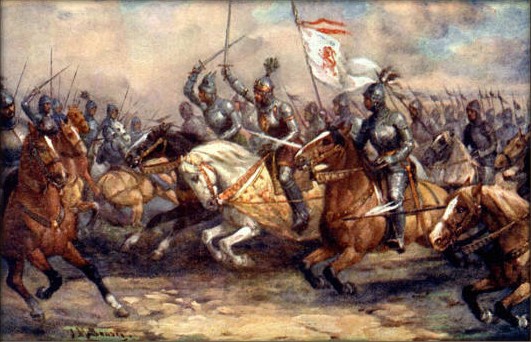BLIND TO HIS FATE - THE HEROIC LIFE AND DEATH OF JOHN OF BOHEMIA
Today the Grand Duchy of Luxembourg is best known as a financial, judicial and administrative centre of the European Union but during the Middle Ages the Counts of Luxembourg competed with the German Wittlesbachs and the Austrian Hapsburgs for control of the vast Holy Roman Empire. In 1312 Henry VII became the first Count of Luxembourg to wear the imperial crown and the marriage of his young son played an important part in Henry’s election.
In 1310, the 14 year old John of Luxembourg wed the 18 year old Elizabeth of Bohemia and by these diplomatic nuptials, Henry succeeded in depriving his rivals of vital territory at the heart of Europe. However, Henry had to take control of his daughter-in-law’s kingdom by force and the marriage was a disaster. Despite providing her husband with seven children (including the future Emperor Charles IV) they lived almost separate lives and in 1323 rumours of Elizabeth’s involvement in a plot against her husband began to circulate. Fearful for his crown, John kidnapped his three eldest children (Margaret, Bonne and Charles) and sent them to France. They never saw their mother again.
Though John succeeded in pacifying Bohemia, and even enlarged its boundaries, his treatment of Elizabeth did not endear him to his subjects. Always considered a foreigner by the Bohemian nobility, John wisely let viceroys govern his kingdom whilst he fought numerous campaigns in Denmark, Prussia, Poland, Hungary, Lithuania and even Italy. For ten years John of Bohemia was celebrated as the perfect example of a chivalrous knight errant but in 1336, whilst crusading in the Baltic with the German Teutonic Order, he contracted the ophthalmia which left him blind.
There were many who whispered that John’s blindness must be a punishment from God but on the outbreak of The Hundred Years War in 1337 he ignored these rumours, as well as his affliction, and declared that he’d fight for France. In the tenth year of the war the ageing king, together with his son Charles, joined the French army marching to meet the English invaders at Crecy but the subsequent battle ended in humiliating defeat for the French and among the dead was John the Blind. The medieval chronicler Froissart, writing around 1370, described his gloriously chivalric end:
“... when he [John] understood the order of the battle, he said to them about him: 'Where is the lord Charles my son?' His men said: 'Sir, we cannot tell, we think he be fighting.' Then he said: 'Sirs, ye are my men, my companions and friends in this journey: I require you bring me so far forward, that I may strike one stroke with my sword.' They said they would do his commandment, and to the intent that they should not lose him in the press, they tied all their reins of their bridles each to other and set the king before to accomplish his desire…”
The Chronicle of Prague [written slightly earlier in 1368] also quotes John as saying:
“Far be it that the King of Bohemia should run away. Instead, take me to the place where the noise of the battle is the loudest. The Lord will be with us. Nothing to fear. Just take good care of my son!”
Despite being totally blind for almost a decade, John of Bohemia charged the English archers and men-at-arms with predictable results. After the battle, his lifeless corpse was found surrounded by the bodies of his men and their horses - whose bridles were still tied together.
Always a restless soul, even after death John of Bohemia refused to lie peacefully in his tomb. At first the king’s mortal remains were interred in Luxembourg city’s ‘Old Abbey’ and after this monastery was destroyed in 1543, his bones were moved to the ‘New Abbey’ built nearby. During the French Revolution, the relics were entrusted to the Boch family, of Villeroy & Boch fame, who hid them in an attic. When, in 1833, the Prussian king Frederick William III visited the Rhineland (which had been awarded to Prussia after the Napoleonic Wars) Jean-Francois Boch presented him with the relics.
Frederick William, who claimed descent from John, took the bones to Kastel-Staadt, which lies on the German side of the border with Luxembourg, and had a chapel specially built to house them but still the old king could not rest in peace. In 1945, with Hitler’s Germany on the verge of defeat, the government of Luxembourg quietly liberated John of Bohemia and brought his remains to Luxembourg city’s Notre Dame Cathedral where they now lie.

BLIND JOHN OF BOHEMIA CHARGING INTOBATTLE
Josef Mathauser's (1846 - 1917)